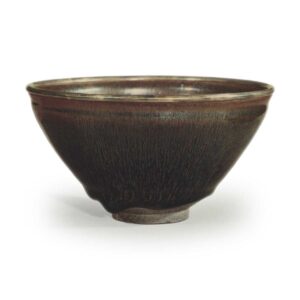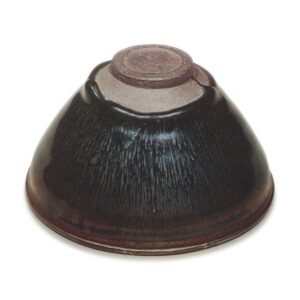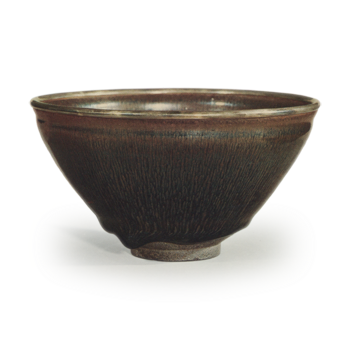

Height: 6.9-7.0cm
Diameter: 12.5cm
Outer diameter of foot ring: 3.8-3.9cm
Height of foot ring: 0.6cm
This is a typical example of a tea bowl with a particularly elegant shape and beautiful finish, even among the so-called rabbit-ear bowls.
The clay is a slightly rough clay with a high iron content, and it is fired to a dark grayish brown. The shape is the standard Kenzan form with the mouth twisted back, and the foot is a small, shallowly incised Janome foot. A glossy black glaze is applied thickly both inside and out, and the glaze breaks off around the waist on the outside, leaving the body exposed below. The bottom edge of the glaze is thickly glazed, with a protruding drip in one place. The glaze flows and becomes thin at the top, taking on a brownish color, and crystals float around the rim, shining silver. It is decorated with a silver border.
Even though the black glaze is glossy, it is not the kind of sheen that shines like a flash, but a calm, subdued sheen. Needless to say, this is a characteristic of the taste of the tea bowls that have been handed down over the generations, but in the case of the Kenkan bowl in particular, it is thought that this is due to the fact that it has been handled and loved by many people over the years, as well as the fact that the glaze of the Kenkan bowl itself has a nature that makes it easy to become familiar with.
Although it is not very noticeable in this bowl, the fact that there are many examples of Kenzan bowls with scratches on the glazed surface is probably for the same reason.
The entire glazed surface is covered in beautiful rice-grain patterns. They sparkle like blue shells, and show the characteristics of so-called “blue rabbit-hair bowls”. In particular, the countless grains of rice that flow in unison towards the deep, slightly wide interior of the bowl are intoxicating, like the mysteries of the universe. It is said that the Song Dynasty poets praised its beauty so much because they could not ignore its symbolic beauty.
It is thought to have been made in the Jian kilns of Fujian Province around the 12th or 13th century. The ‘Great View of Tea’ by Emperor Huizong is said to have chosen the ‘Tuo Hao’ bowl, and there is a similar passage in the ‘Tea Record’ by Cai Xiang, so it is thought that the ‘Tuo Hao’ bowl was popular in the Northern Song Dynasty. However, it is not clear what it refers to.
The origin of this type of bowl is not known, but it is a fine example of the type that has come down to us in Japan, and is counted as one of the typical examples of the Jianfeng bowl.
(Hasebe Gakuji)



